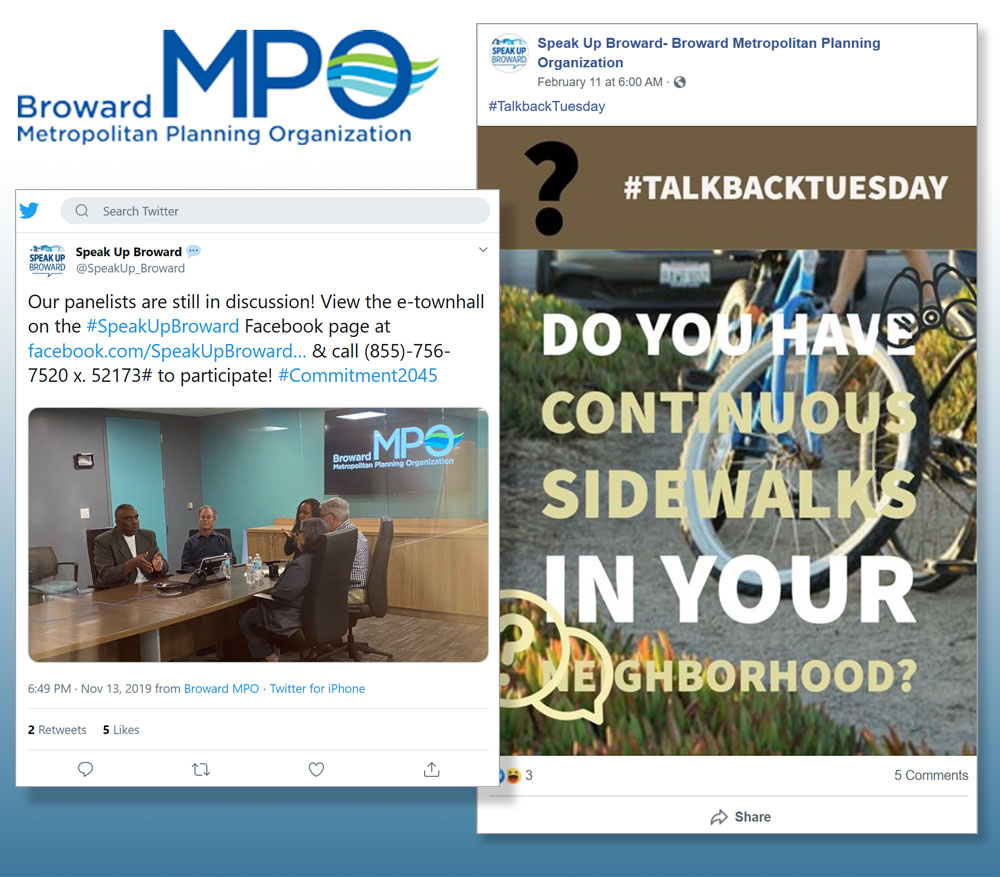March 12, 2020
Innovation of the Month:
Virtual Public Involvement
In the realm of virtual public involvement, social media platforms are an important tool to reach people from all segments of the population. The Broward Metropolitan Planning Organization (MPO) has taken social media use to a new level.
The Broward MPO serves a population of greater than 1.9 million in South Florida, providing regional transportation and land use planning and development services. The MPO has become a national leader in educating and engaging the public through a social media strategy across multiple channels that revolves around the four "I"s of producing influential content:
- Inform the public
- Involve the public
- Include the public
- Improve the public participation process
The Broward MPO uses a strategic social media calendar to plan their social media campaigns and best determine the use of the social media channels.

Some of the MPO's successful campaigns include: #speakupbroward, #talkbacktuesday, and #makingwaves. Programs like these can be created by any agency through leveraging partnerships with advisory committees and/or local non-profit organizations.
The MPO is also an expert in creating, fresh and eye-catching content that includes articles, coverage of community and outreach events, project updates, and MPO initiatives. It also uses video to reach outside the walls of its office and directly into the homes, living rooms, businesses, and schools of its community. Using technology such as Facebook Live for e-townhalls, the agency has communicated and interacted with over 14,000 people in its area in these events.
In addition to its forward-leaning use of social media for public involvement, the Broward MPO has been extremely active in helping other organizations through peer exchanges and other in-person events. The MPO was featured as a lead expert at the Southeastern Connecticut Council of Government's Virtual Public Involvement Peer Exchange Workshop in November 2019, participated in FHWA's Extending our Reach video and webinar series, and has shared notable resources such as their social media policy and social media content calendar with their peers.
If you would like to learn more about how your agency can become more active and effective with social media, please contact Scott Allen or Jody McCullough, of the FHWA Office of Planning, Environment, and Realty.
Value Capture Helps Colorado's Largest Transportation Project Benefit Travelers and Communities
Joint development is a value capture technique that develops a transportation project and adjacent private real estate or infrastructure along with a private developer. With these types of projects, the private developer gives money towards or directly implements public transportation improvements co-located with nontransit real estate development. In Denver, such an agreement with a private developer is helping fund Colorado's largest-ever transportation project.
The Central 70 project will remove a 50-year-old, 2-mile viaduct, replacing it with a lowered section of interstate capped by a 4-acre park uniting the Swansea and Elyria neighborhoods. The public space is expected to feature a small amphitheater, a splash park, a sports field, play areas, and room for farmers' markets and community events.
Plans include redesigned shoulders and interchanges to reduce crashes and improve safety, while lowering travel time by up to one-half by 2035 and accommodating the needs of a growing population. The major funding source is from Colorado Bridge Enterprise, which is primarily a bridge safety surcharge on vehicle registration fees.
Value capture methods can help your agency and your communities. Find out how by contacting Stefan Natzke, FHWA Office of Planning, Environment, and Realty, or Thay Bishop, FHWA Center for Innovative Finance Support.
Virginia Emphasizes FoRRRwD Countermeasures in Systemic Safety Implementation Program
The Virginia Department of Transportation (VDOT) greatly accelerated implementation of systemic safety improvements by dedicating over 80 percent of Highway Safety Improvement Program (HSIP) funds to systemic safety countermeasures, funding nearly $140 million through fiscal year 2025. More than half of this funding is specifically geared to reducing rural roadway departures.
A major part of VDOT's safety target setting methodology analyzed the impact of systemic versus spot improvements. The methodology demonstrated that systemic projects result in significantly more return on investment than spot improvements. This prompted VDOT to shift the HSIP funding policy to focus more on systemic improvements and require an implementation plan.
The plan focuses on eight systemic safety countermeasures, including curve signage, shoulder wedge, centerline rumble strips, and edgeline rumble strips. VDOT estimates the countermeasures that specifically target roadway departure crashes will save 54 lives and prevent 831 injuries every year when fully deployed.
For more information on VDOT's safety target setting methodology, contact Mark Cole, State highway safety engineer for VDOT.
About EDC
Every Day Counts, a State-based program of the Federal Highway Administration’s Center for Accelerating Innovation, works with State, local, and private sector partners to encourage the adoption of proven technologies and innovations to shorten and enhance project delivery.


